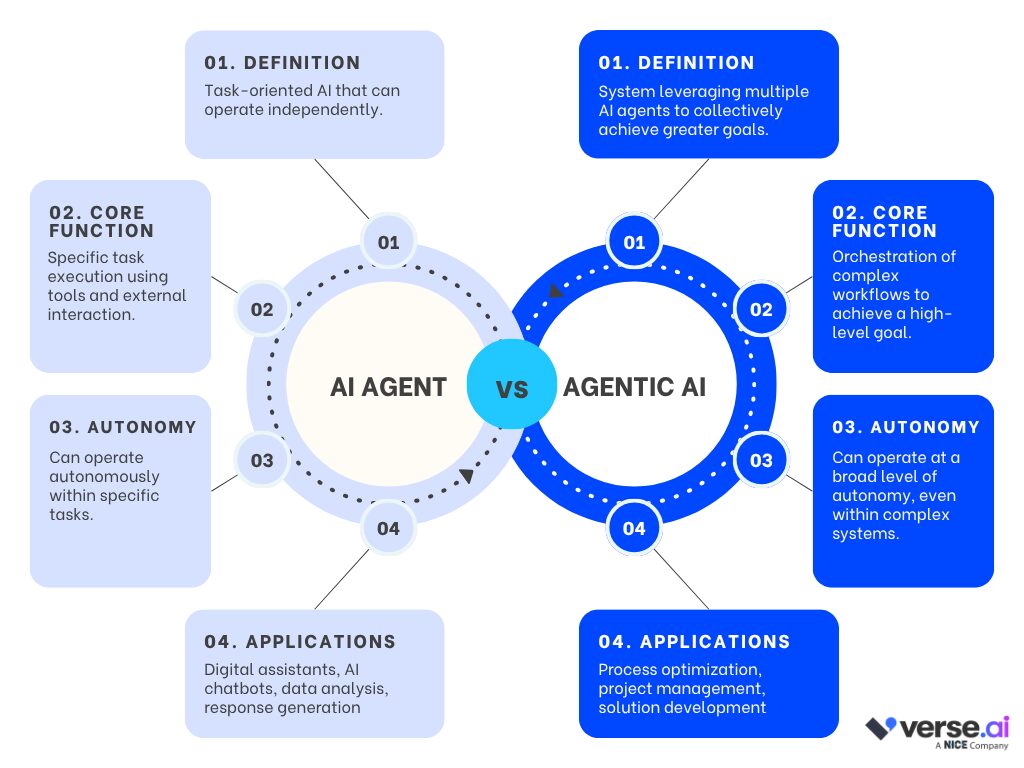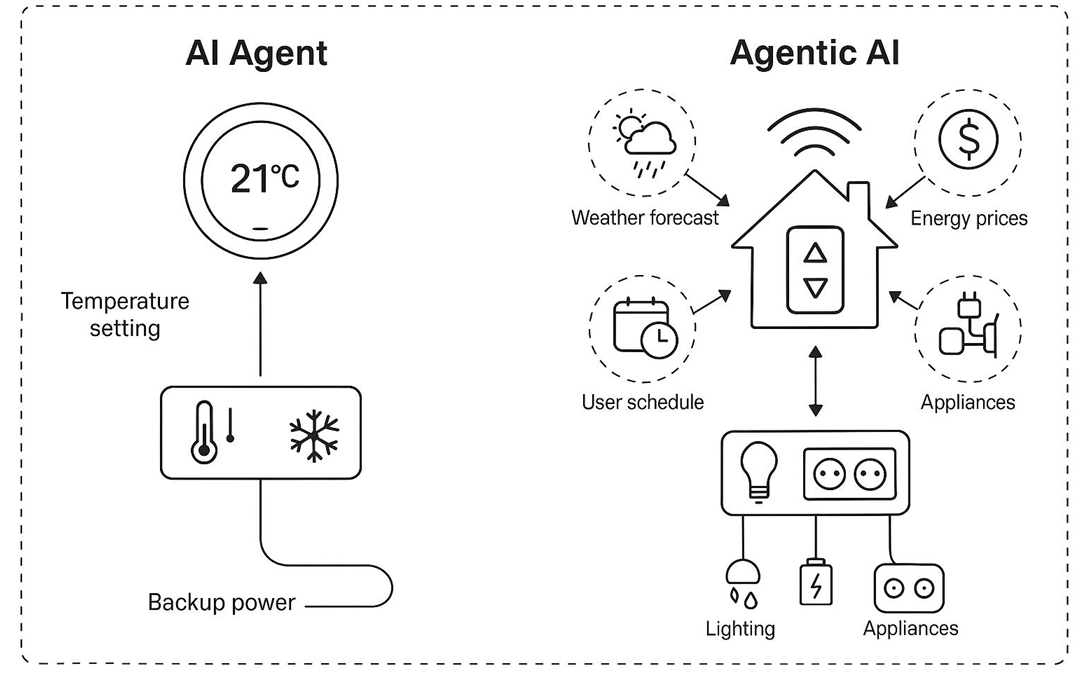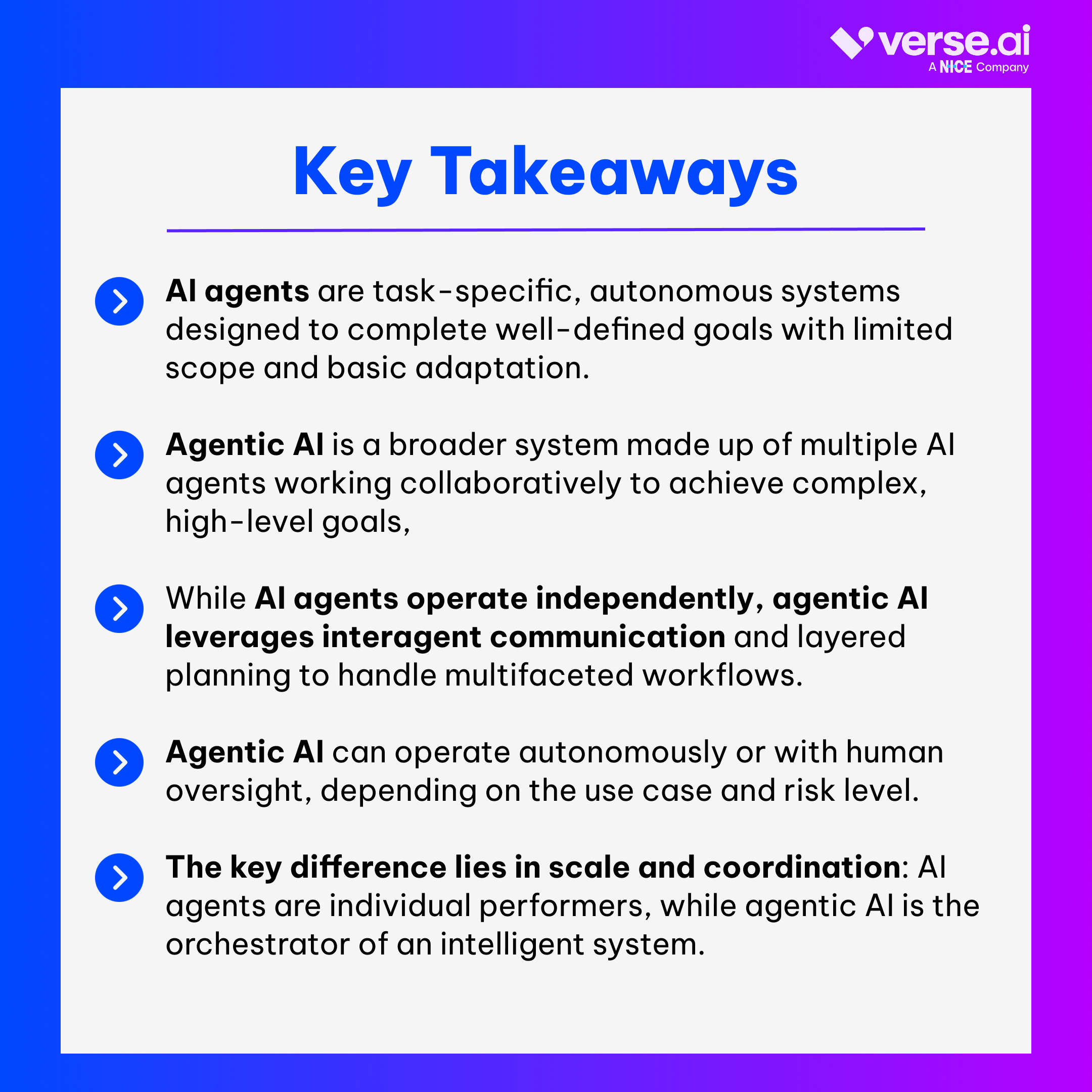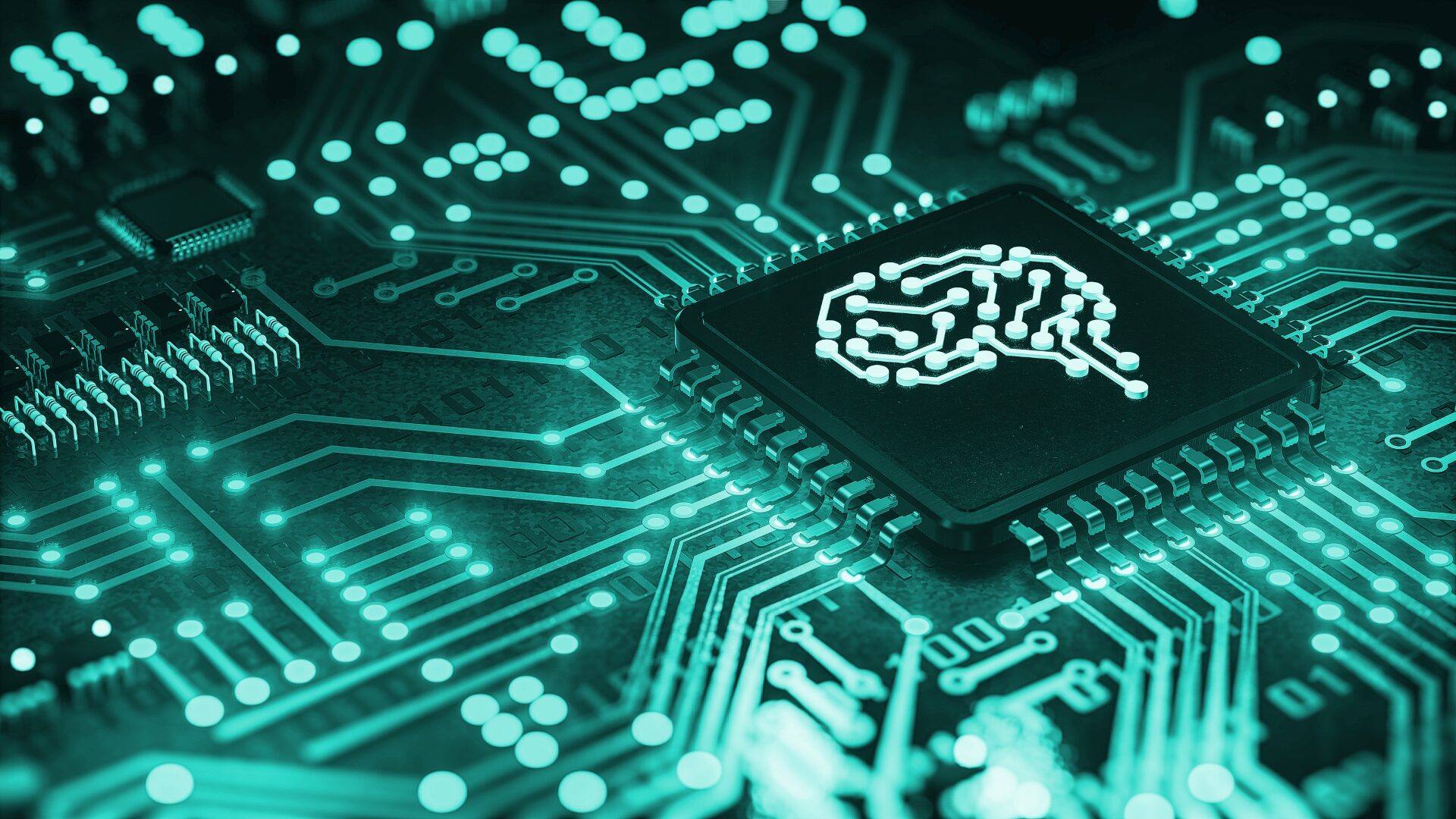As agentic AI emerges as a revolutionary shift in the field of AI, many different definitions are already floating around—especially when it comes to comparisons between agentic AI vs. AI agents.
Are agentic AI and AI agents the same? The answer is both yes and no—depending on how you look at it.
So what is agentic AI? How are agentic AI and AI agents different?
This article aims to answer these questions and more in a technically-accurate but practical way.
Let’s take a deep dive into what agentic AI is, and how agentic AI compares to AI agents.
What are AI agents?
To best understand agentic AI, we should first understand what AI agents are.
AI agents are task-oriented, goal-directed AI that can have varying degrees of autonomy.
Operating automatically within specific and defined scopes, AI agents understand inputs, conduct reasoning, and take actions in order to achieve their specified goal.
AI agents do not work well without a narrow, well-defined scope. If you try to have an AI agent do too many tasks on too broad of a scale, it will not be effective.
Defining features of AI agents include:
- Autonomy: they are able to function without human intervention.
- Task-specificity: they are built for specific, well-defined tasks.
- Adaptation: they have basic mechanisms (such as basic learning and feedback loops) for responding to dynamic inputs (for example, user feedback).
While AI agents can operate autonomously within their specific parameters, they can be built for human supervision as well.
Customer-facing AI, such as Verse, often leverages human-in-the-loop to ensure the AI does not give inaccurate, false, or non-compliant responses to customers.
How AI agents use LLMs
In a basic sense, modern AI agents work using large language models (LLMs) (or large image models, LIMs) for reasoning and perception.
Trained on large data sets, LLMs help AI agents to understand inputs and conduct reasoning to go beyond automation. For example, an AI agent for customer support uses an LLM to understand customer inputs and respond appropriately.
What is agentic AI?
According to NVIDIA, agentic AI represents “the next frontier of artificial intelligence”.
Agentic AI combines and expands on the capabilities of AI agents.
In essence, agentic AI involves layers of AI agents, taking multiple outputs from these agents and analyzing them to autonomously make decisions.
Agentic AI leverages multiple AI agents to collectively achieve greater goals through communication, reasoning, planning, and shared memory. Its defining characteristic is interagent collaboration to achieve high-level objectives.
Agentic AI can operate autonomously, but can be used with human-in-the-loop also—depending on what it is built for. Higher-stakes use cases, like cybersecurity, will use agentic AI systems with human-in-the-loop to validate solutions.
Like AI agents, agentic AI is goal-oriented, but its goals are more expansive than that of AI agents. Instead of operating as a singular unit, agentic AI consists of multiple agents that each have specific tasks related to its goal.
While AI agents can’t effectively handle complex workflows or multiple tasks, agentic AI can.
By using interagent collaboration, it can divide its objective into smaller goals, which are pursued by its multiple AI agents.
For example, if you wanted to use agentic AI to solve for customer satisfaction, it would use multiple layers of AI agents for different related tasks.
Here is one example of how agentic AI uses AI agents to achieve this greater goal by dividing it into smaller tasks:
- The agentic AI has one goal: to create an action plan to boost customer satisfaction and reduce churn.
- Within the agentic AI, one AI agent would analyze CRM data to identify customers most at risk for churn.
- The agentic AI would then build a plan around how to respond to these customers, and validate solutions.
- One AI agent’s task would then be to create three different solutions (for example), drafting three different emails to engage with these at-risk customers.
- Another AI agent would then analyze the letters for quality and effectiveness—if one or more are not effective, this agent could write a better one.
- The agentic AI would then analyze the letters again to determine which would be most effective.
- If the agentic AI is fully-autonomous, it would then automatically send the best letter to the at-risk customers it has identified. If the agentic AI is supervised by a human, the human would then review the AI’s letter before sending it.
How agentic AI works
In order to achieve desired outcomes, agentic AI uses four actions:
- Perceive: Multiple AI agents perform their various specific tasks to “bubble up” their individual outputs to a centralized decision-making core.
- Reason: Using a large language model (LLM) and retrieval-augmented generation (RAG), agentic AI can conduct reasoning and develop solutions that support their overall objectives.
- Act: Agentic AI then executes tasks by “directing” other AI agents to carry out the planned solution.
- Learn: Agentic AI uses feedback loops to improve over time based on the outcome of their previous actions.

Key differences: agentic AI vs. AI agents
AI agents and agentic AI are both autonomous forms of AI that can interact with users and their environments.
However, there are clear differences when it comes to their core functions, scope, operational complexity, and applications.

A real-world example that illustrates the differences between AI agents and agentic AI is smart home systems. (This example has been summarized from this study by Ranjan Sapkota, Konstantinos I. Roumeliotis, and Manoj Karkee.)
The AI agent takes the form of the smart thermostat, which sets the temperature based on user inputs. This agent has limited autonomy, learning user schedules and reducing energy consumption during their absence. The agent operates independently, executing one well-defined task without any broader goals.
However, the agentic AI represents the smart home ecosystem as a whole, incorporating multiple agents to manage various aspects, such as weather forecasting, daily scheduling, energy consumption optimization, security, etc.

Collaboratively, the AI agents align towards one goal—for example, energy efficiency. Each agent acts as one component, with limited scope, while the agentic AI divides the goal and uses interagent communication to facilitate goal achievement.
Video explainer
In this short video, Verse Senior Product Manager Matt White defines agentic AI and AI agents and outlines their key differences.
Agentic AI vs. AI agents: Applications
Examples of AI agents
Common applications of AI agents include:
- Personalized recommendations: Based on user behavior, AI agents can personalize recommendations. Think: your YouTube recommendations or Spotify-created playlists—AI agents are even responsible for relevant product recommendations on ecommerce sites.
- Data reporting: AI agents incorporated into dashboards can allow users to see patterns within data and even quickly create reports based on user inputs.
- Customer engagement: AI agents can help to automate customer engagement, reaching out to leads automatically, responding to customer queries, and helping with support ticket triage.
- Scheduling assistants: AI agents can help with scheduling, rescheduling, and meeting conflicts, identifying time slots based on user behavior and availability inputs. Think: the scheduling assistant on your Google or Outlook calendar.
Examples of agentic AI
Common applications of agentic AI include:
- Advanced robotics: Agentic AI coordinates collaboration in multi-robot systems. For example, drone-based orchard inspection. While agricultural drones map trees, identify diseased fruits. With this information, agentic AI optimizes robotic fruit harvesting to pick the fruit, classify by quality, and haul fruit to appropriate bins.
- Decision support: Agentic AI can incorporate multiple facets of one decision to help optimize the decision-making process. For example, agentic AI is growing in the medical field, helping to support medical decisions by assigning tasks such as diagnostics, monitoring, and treatment planning to AI agents. The agentic AI then combines these through shared memory to make recommendations.
- Enterprise workflows: Agentic AI can be used to manage processes in an enterprise setting. For example, agentic AI can be used in cybersecurity incident response. One AI agent detects the threat, while another agent classifies the threat. A third agent uses compliance frameworks to classify it in a regulatory sense. Another agent creates a mitigation plan and evaluates risks. Under the agentic AI, these agents can coordinate recommended actions to human analysts.
Agentic AI vs. AI agents: Key takeaways

What does the future look like for agentic AI?
As agentic AI can automate complex workflows with varying levels of autonomy, many people believe that agentic AI represents the future of AI solutions.
For businesses, agentic AI is a costly solution at this time—though this will likely change in the future.
If you’re interested in eventually adopting agentic AI for complex workflows, a great step is to start setting up individual AI agents that will eventually work together.
Verse’s AI agent
Verse is your AI agent for customer engagement and improved conversions.
Verse’s fully-managed AI agents work to instantly engage leads via SMS to ensure instant response for every single lead.
As the Verse platform automatically collects lead source data and insights, it’s an easy way to enrich your decision-making process when it comes to sales, marketing, and lead generation.
We work with you on scripting and compliance, and our fully-managed platform includes our team of human concierges for human-in-the-loop quality assurance.
If you’re looking to get started with AI agents, Verse might be the tool for you. Learn more in our demo videos or book your personalized demo today.
Agentic AI vs. AI agents: FAQ
What is agentic AI?
Agentic AI refers to an advanced form of artificial intelligence made up of multiple AI agents working together to achieve complex, high-level goals. These systems use perception, reasoning, action, and learning in a coordinated, often autonomous way to complete multifaceted tasks through interagent collaboration.
What is the difference between agentic AI and AI agents?
AI agents are task-specific, goal-directed systems that function autonomously within narrow scopes. In contrast, agentic AI consists of multiple AI agents working together toward broader objectives. While AI agents operate independently, agentic AI uses layered coordination, planning, and shared memory to achieve more complex outcomes.
Are agentic AI and AI agents the same thing?
Not exactly. AI agents are building blocks—autonomous systems designed to complete individual tasks. Agentic AI is the system that brings these agents together, enabling them to collaborate and reason collectively. So while agentic AI uses AI agents, it operates at a more advanced and integrated level.
How does agentic AI use large language models (LLMs)?
Agentic AI systems often use LLMs (like GPT models) for perception and reasoning. These models help the system interpret inputs, generate solutions, and plan next steps. LLMs also enable communication between agents, making it possible for agentic AI to manage dynamic tasks more effectively.
What are real-world examples of agentic AI?
A practical example is a smart home ecosystem: individual AI agents might control the thermostat, lighting, and security system, while an agentic AI system coordinates all of them to optimize for a broader goal—like energy efficiency or home security—by enabling them to communicate, adapt, and make decisions as a unit.
Why is agentic AI considered the next frontier in AI?
Agentic AI represents a shift from single-task automation to multi-agent intelligence capable of handling complex, dynamic problems. It moves beyond isolated AI agents by integrating reasoning, planning, and interagent collaboration—making it a promising foundation for more adaptable, scalable AI systems.


